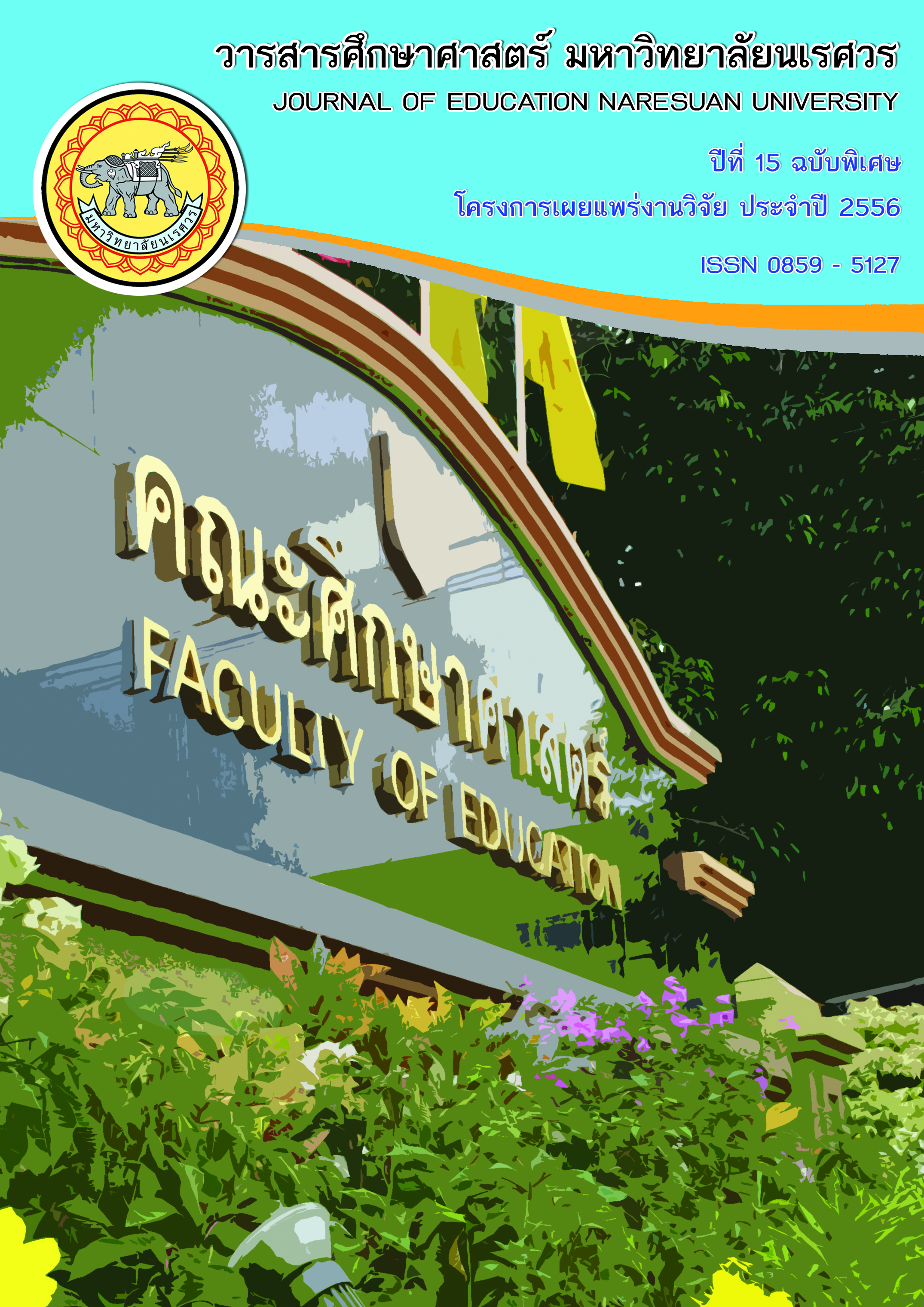รูปแบบการพัฒนาสมรรถนะการปฏิบัติงาน ของคณะกรรมการสถานศึกษาขั้นพื้นฐานขนาดเล็ก
Main Article Content
Abstract
บทคัดย่อ
การวิจัยครั้งนี้ มีวัตถุประสงค์เพื่อพัฒนารูปแบบการพัฒนาสมรรถนะการปฏิบัติงานของคณะกรรมการสถานศึกษาขั้นพื้นฐานขนาดเล็ก โดยมีขั้นตอนการวิจัย 3 ขั้นตอนดังนี้ ขั้นตอนที่ 1 ประกอบด้วย 3 ส่วนดังนี้ 1) ศึกษาแนวคิด ทฤษฎีงานวิจัยที่เกี่ยวข้องและวิเคราะห์บทบาทอำนาจหน้าที่ตามกฎหมายของคณะกรรมการสถานศึกษา 2) สัมภาษณ์ผู้ทรงคุณวุฒิ เกี่ยวกับสมรรถนะที่จำเป็นในการปฏิบัติงานและวิธีการพัฒนาสมรรถนะการปฏิบัติงานของคณะกรรมการสถานศึกษาขั้นพื้นฐาน 3) สัมภาษณ์คณะกรรมการสถานศึกษาประถมศึกษาขนาดเล็กที่อยู่ในโรงเรียนปฏิบัติดีเกี่ยวกับสมรรถนะที่จำเป็นในการปฏิบัติงานและวิธีการพัฒนาสมรรถนะการปฏิบัติงานของคณะกรรมการสถานศึกษาขั้นพื้นฐาน ขั้นตอนที่ 2 การสร้างรูปแบบการพัฒนาสมรรถนะการปฏิบัติงาน ของคณะกรรมการสถานศึกษาขั้นพื้นฐานขนาดเล็ก โดยใช้วิธีการประชุมสนทนากลุ่ม (Focus Group Discussion) ขั้นตอนที่ 3 การประเมินรูปแบบการพัฒนาสมรรถนะการปฏิบัติงานของคณะกรรมการสถานศึกษาขั้นพื้นฐานขนาดเล็ก ใช้วิธีประชุมแสดงความคิดเห็น โดยผู้อำนวยการสำนักงานเขตพื้นที่การศึกษาประถมศึกษา และผู้อำนวยการสถานศึกษาที่อยู่ในโรงเรียนประถมศึกษาขนาดเล็ก
ผลการวิจัยพบว่า
1. รูปแบบการพัฒนาสมรรถนะการปฏิบัติงานของคณะกรรมการสถานศึกษาขั้นพื้นฐานขนาดเล็กมี 3 ส่วน คือ ส่วนที่ 1 สมรรถนะ การปฏิบัติงานของคณะกรรมการสถานศึกษาขั้นพื้นฐานขนาดเล็ก ประกอบด้วยสมรรถนะ ที่ 1 ความรู้ในด้านการบริหารจัดการศึกษา สมรรถนะที่ 2 ความรู้ในด้านการบริหารวิชาการ สมรรถนะที่ 3 การให้คำปรึกษา สมรรถนะที่ 4 การกำกับติดตาม ตรวจสอบและประเมินผล สมรรถนะที่ 5 การประสานงาน สมรรถนะที่ 6 การมีส่วนร่วม สมรรถนะที่ 7 การให้ความช่วยเหลือ ส่งเสริม สนับสนุน และสมรรถนะที่ 8 มีอุดมการณ์ ทุ่มเท เสียสละ ส่วนที่ 2 วิธีการพัฒนาสมรรถนะการปฏิบัติงาน มีส่วนประกอบดังนี้ 1) หลักการพัฒนา ประกอบด้วย หลักการคำนึงถึงการเรียนรู้ของผู้ใหญ่ การคำนึงถึงความพร้อมพื้นฐานความรู้และประสบการณ์ของคณะกรรมการ และหลักการพัฒนาแบบองค์รวมโดยยึดการเรียนรู้จากการปฏิบัติงานของสถานศึกษาโดยภาคีเครือข่ายที่เกี่ยวข้องร่วมพัฒนา 2) วัตถุประสงค์การพัฒนาประกอบด้วย ด้านผลผลิต (Output) ด้านผลลัพธ์ (Outcome) 3) วิธีการพัฒนาสมรรถนะมี 13 วิธี คือ การฝึกอบรม การประชุมเชิงปฏิบัติการ ศึกษาดูงานกับโรงเรียนที่ปฏิบัติดี การสร้างเครือข่าแลกเปลี่ยนเรียนรู้ ศึกษาเอกสาร/สื่อที่เกี่ยวข้อง ศึกษาจากคู่มือการปฏิบัติงาน การเรียนรู้ด้วยตนเอง การสอนงาน การเป็นพี่เลี้ยง การให้คำปรึกษาแนะนำ การฝึกงานและทำงานร่วมกับผู้เชี่ยวชาญ ใช้กิจกรรมนันทนาการ การระดมสมอง 4) ผู้พัฒนาและบทบาทของผู้พัฒนาสมรรถนะการปฏิบัติงานของคณะกรรมการสถานศึกษาขั้นพื้นฐาน ประกอบด้วย ผู้พัฒนาระดับเขตพื้นที่ ผู้พัฒนาระดับสถานศึกษา และผู้พัฒนาที่อยู่ในสถานศึกษาปฏิบัติดี 5) กระบวนการพัฒนาซึ่งประกอบด้วย 5 ขั้นตอน คือ ขั้นตอนที่ 1 วิเคราะห์ความต้องการจำเป็นในการพัฒนา ขั้นตอนที่ 2 การจัดทำแผนพัฒนา ขั้นตอนที่ 3 การกำหนดและการออกแบบวิธีการพัฒนา ขั้นตอนที่ 4 ดำเนินการตามแผน และขั้นตอนที่ 5 การประเมินและติดตามผล ส่วนที่ 3 เงื่อนไขความสำเร็จ ประกอบด้วย ผู้พัฒนาต้องกำหนดวิธีการพัฒนาให้เหมาะสมสอดคล้องกับสมรรถนะที่ต้องการพัฒนา ผู้พัฒนาต้องคำนึงถึงความแตกต่างระหว่างบุคคล ผู้บริหารสถานศึกษาซึ่งเป็นคณะกรรมการและเลขานุการโดยตำแหน่งและข้าราชการครูที่เป็นผู้แทนในคณะกรรมการต้องมีวิสัยทัศน์และเป็นผู้นำในการพัฒนา ระดับเขตพื้นที่การศึกษาต้องกำหนดเป็นนโยบายพร้อมทั้งให้การส่งเสริม สนับสนุนในการพัฒนาและเป็นผู้พัฒนา
2. การประเมินรูปแบบการพัฒนาสมรรถนะการปฏิบัติงานของคณะกรรมการสถานศึกษาขั้นพื้นฐาน พบว่า รูปแบบการพัฒนาสมรรถนะการปฏิบัติงานของคณะกรรมการสถานศึกษาขั้นพื้นฐานขนาดเล็กที่พัฒนา ขึ้นมีความเป็นไปได้สำหรับการนำไปใช้ในสถานการณ์จริงด้านกระบวนการพัฒนาสมรรถนะและด้านเงื่อนไขความสำเร็จอยู่ในระดับมากที่สุด ส่วนด้านอื่น ๆ มีความเป็นไปได้ในการนำไปใช้อยู่ในระดับมากตามลำดับ
คำสำคัญ: รูปแบบการพัฒนาสมรรถนะ/ การปฏิบัติงาน/ คณะกรรมการสถานศึกษาขั้นพื้นฐานขนาดเล็ก
Abstract
This research was aimed at developing three steps of the research process : step 1) to study the performance and how to improve the operational competency of committee of the basic education for small-sized schools consists of three small sections 1.1) A study of concepts, theory, research and analysis related to the legal authority of the school committee 1.2) interviewed experts in issue of Management by the organization committee, the Educational Administration and Human Resource Management, competencies needed to practice and how to improve the performance to improve committee of the basic education for small-sized schools. 1.3) interviewed committee of the basic education for small-sized schools about the good performance, how to improve performance and the required performance of the education process 2) Step 2: to draft a model to improve the operational competency of committee of the basic education for small-sized schools by using Focus Group Discussion. 3) Step 3 to improve the operational competency of committee of the basic education for small-sized schools by seminar and 20 directors of the basic education for small-sized schools.
The results showed that
1. A model to improve the operational competency of committee of the basic education for small-sized schools consists of three parts: parts 1 competencies, the competencies of the Basic Education for small-sized consisted of two knowledge competencies; the first knowledge management competencies, the second knowledge management skills. The skill competencies consisting of three competencies; the third counseling, the forth monitoring, the forth monitor and evaluate the competencies of the four coordination. Attributes have two competencies; the sixth competencies; participating, the seventh; support and assistance competencies, the eighth idealist dedicated Sacrifice. Part 2 How to develop competencies. Operational components: 1) the development includes consideration of adult learning regarding to the availability, knowledge and experience of the Board. And holistic development based on learning from the practice of education with network associates 2) Development objectives including productivity and objective outcomes 3) How to develop operational competencies includes 13 ways to practice; training workshops, Education at the school is a good practice, Networking exchange study/media related, Study your operations, The self-learning, coaching, mentoring. Consulting advice, Training and working with experts, Use activities, Brainstorm and 4) the developer and development role comprised of director of Primary educational service area office and directors of best practice schools. 5) Development process consists of five steps: 1) analyzing needs 2) Development Plan 3) the design and development methods, 4) implementing the plan. development, 5) evaluation and monitoring of the three part; conditions for success include 1) the developer must determine how to develop the appropriate competencies requirements, 2) the development must take into account the individual differences 3) educational administrators, secretary to the Commission and by the teacher and a representative of the Commission must have the vision and leadership in the development. 4) to define the area of education policy and to promote Support the development and the developer.
2. Evaluation a model to improve the operational competency of committee of the basic education for small-sized schools found that a model to improve the operational competency of committee of the basic education for small-sized schools has Developed with the possibility for its use in real-life situations, the process of developing the condition, performance and success at the highest level, the other side, the possibility in using was in high level, respectively
Key words: the operational competency/ committee/ basic education for small-sized schools
Article Details
The owner of the article does not copy or violate any of its copyright. If any copyright infringement occurs or prosecution, in any case, the Editorial Board is not involved in all the rights to the owner of the article to be performed.


